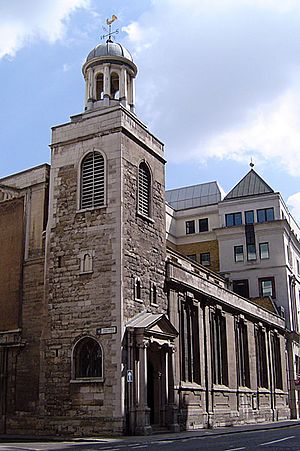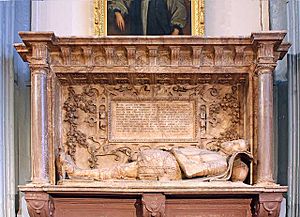St Katharine Cree facts for kids
Quick facts for kids St Katharine Cree |
|
|---|---|

View from the southwest, showing the 16th century tower
|
|
| OS grid reference | TQ33398114 |
| Location | London, EC3 |
| Country | England |
| Denomination | Church of England |
| Website | Official website: http://www.stkatharinecree.org |
| History | |
| Dedicated | 31 January 1631 |
| Architecture | |
| Heritage designation | Grade I listed building |
| Style | Jacobean |
| Years built | 1628–30 |
| Administration | |
| Diocese | London |
The Guild Church of St Katharine Cree is a historic Anglican church. You can find it in the Aldgate area of the City of London. It is located on the north side of Leadenhall Street, close to Leadenhall Market. This church was first started in 1280. The building you see today was built between 1628 and 1630. It used to be a local parish church, but now it serves as a guild church.
Contents
History of St Katharine Cree
The First Church Building
The area served by this church has been around since 1108. Back then, it was connected to the Augustinian Holy Trinity Priory, Aldgate. This priory was also known as Christ Church. It was founded by Maud, who was Queen to King Henry I. People living nearby used the priory church for their services. However, this caused problems and disturbed the priory's daily life.
To fix this, the prior (the head of the priory) decided to create a separate church in 1280. This new church was named St Katharine Cree. It was built in what used to be the priory's churchyard. It might have started as a small chapel for the cemetery. The name "Cree" comes from "Crichurch," which was a shorter way of saying "Christ Church."
At first, a canon (a type of priest) from the priory looked after the church. But this still didn't work out well. So, in 1414, St Katharine Cree became its own parish church. This meant it had its own dedicated area and community. The tall tower you see today was added around 1504.
In the late 1500s, a writer named John Stow described the old church:
this church seemeth to be very old; since the building whereof the high street hath been so often raised by pavements that now men are fain to descend into the said church by divers steps, seven in number.
The Current Church Building

The church building we see now was constructed between 1628 and 1630. It kept the old Tudor tower from the previous church. The new building was made larger. It included a piece of land that used to be a cloister (a covered walkway) on its north side. The floor level of the new church was also built much higher.
The rebuilt church was officially opened by William Laud, who was the Bishop of London at the time. This happened on January 31, 1631. The special clothes he wore and the way he performed the opening ceremony were later used against him. During his trial for heresy, some people called Puritans accused him of acting too much like a Catholic. Today, there is a special chapel in the church that remembers him.
St Katharine Cree was lucky and survived the Great Fire of London in 1666. It also only had minor damage during the London Blitz in the Second World War. However, it needed a lot of repair work in 1962 because of structural issues. Today, it is one of London's special Guild churches.
St Katharine Cree is a very important example of Jacobean style. This was a time when not many new churches were built. It is the only Jacobean church that still stands in London. We don't know who designed it. The church has a tall nave (the main central part). This nave connects to narrow aisles on the sides. These aisles are supported by arches resting on Corinthian columns. The church is about 31 yards (28 m) long and 17 yards (16 m) wide. The ceiling of the nave is about 37 feet (11 m) high.

The chancel (the area around the altar) has a beautiful rose window. People say it was designed to look like the much larger one in Old St Paul's Cathedral. That cathedral was destroyed in the Great Fire. This rose window and its stained glass are original, dating back to 1630. The baptismal font (where baptisms happen) is from around 1640.
The vaulted ceiling has special decorations called bosses. These bosses show the coats of arms of 16 of the city's livery companies. They also show the City of London's own coat of arms. From the east end, these are:
- North Aisle – Mercers, Drapers, Skinners, Salters, Dyers and Pewterers
- Nave – The City of London, Fishmongers, Merchant Taylors, Ironmongers, Clothworkers and Leathersellers
- South Aisle – Grocers, Goldsmiths, Haberdashers, Vinters and Brewers
Most of these designs were put in place during a restoration in 1972. It is believed that these Companies used St Katharine Cree for a while after the Great Fire of London in 1666. This was while their own Guild Churches were being rebuilt.
The church is a Grade I listed building. This means it is considered a very important historic building.
Near the south wall of St Katharine's, there is a memorial. It remembers the RMS Lancastria. This was a troopship that sank at sea with many lives lost during the Second World War in 1940. The memorial includes a model of the ship and its original bell.
St Katharine's has a ring of six bells. Five of these bells, including the smallest one, were made by Lester and Pack in 1754. The largest bell was made by Thomas II Mears in 1842. The church clock also has a bell, which was made by Lester and Pack in 1754. In the summer of 2007, these bells were rung for the first time since 1880. A project to raise £60,000 to fix the bells was started in November 2007. The work was finished in 2009. This church is the only one in the City of London where the bells are rung from a room on the ground floor.
Today, St Katharine's is a guild church. It does not have a specific local parish. Instead, it serves people who work in the City of London.
People Connected to St Katharine Cree
Many interesting people have been connected to St Katharine Cree over the years:
- Stephen Charnock (1628–1680) was a Puritan Presbyterian clergyman and theologian. He was born in this church's parish.
- The famous artist Hans Holbein the Younger (died 1543) might be buried here. Both St Andrew Undershaft church and St Katharine Cree claim his grave. St Katharine Cree's claim seems stronger. This is because a nearby abbey had recently been destroyed, and St Andrew Undershaft's graveyard was already full.
- Both Henry Purcell and George Frideric Handel, who were very famous composers, played the organ at this church.
- Sir Nicholas Throckmorton (died 1571) was a diplomat and ambassador. He is buried inside the church.
See also
- Lion sermon
- List of buildings that survived the Great Fire of London
- List of churches and cathedrals of London


